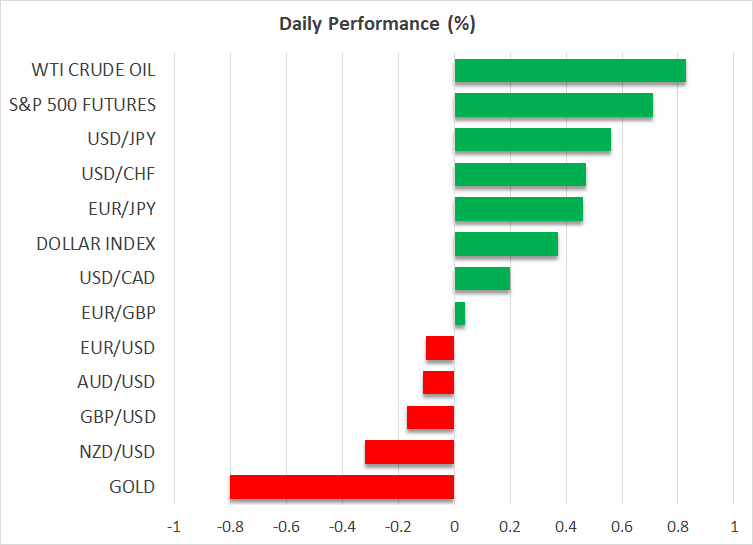The euro extended its gains against the U.S. dollar on Monday, reversing earlier losses as traders digested Germany’s national election results in which the opposition conservatives emerged with a stronger-than-expected mandate. The outcome, combined with growing concerns about the U.S. economic trajectory, shifted investor sentiment toward Europe while casting a cautious light on the path ahead for the world’s largest economy. By Monday morning, the euro had risen about 0.46% versus the dollar, trading near $1.0508. This level marked a recovery from recent declines and underscored how political developments in Germany could influence policy direction across the euro area. Investors remained focused on the implications of a conservative victory for Germany, recognizing that it could set the stage for significant policy shifts aimed at strengthening Europe’s largest economy and, by extension, the eurozone as a whole. Friedrich Merz, the leader of Germany’s Christian Democratic Union, was anticipated to take the role of chancellor in the upcoming administration. Yet, while the election result aligned with market expectations, the trajectory of coalition negotiations loomed as a potential risk factor given the fragmented political landscape.
Germany’s political environment has become markedly more divided in recent years, with the far-right Alternative for Germany party achieving a historic second-place finish. This development increased the complexity of forming a stable governing coalition, elevating the stakes for policy formulation and implementation. For Merz and his CDU, the challenge would be to navigate a fragmented parliament while pursuing reforms that could unlock Germany’s growth potential and address structural economic challenges. The presence of the AfD as a significant political force added a layer of volatility to coalition talks, constraining room for compromise and forcing negotiators to balance competing agendas. Despite the hurdles, market participants were hopeful that a Merz-led government would push forward reforms designed to foster a friendlier business environment, catalyzing investment and potentially lifting productivity and growth in the near-to-medium term. Analysts argued that the election results did not merely reflect a momentary political shift; they signaled the possibility of a broader recalibration of Germany’s economic strategy, one that could influence policy across the euro area and shape the trajectory of euro strength in the months ahead.
Carsten Brzeski, the global head of macro research at ING, highlighted that the forthcoming coalition negotiations would likely be lengthy and complex, potentially delaying any meaningful reforms. He noted that the political divide within Germany could make the negotiation process exceptionally intricate and protracted. Brzeski also warned of a continued risk that, even after the election night, there would be persistent demand for substantial reform of the German economy—demand that could be difficult to satisfy quickly given political constraints. In his assessment, the next government might not deliver transformative changes immediately but could still produce a modest policy package featuring tax adjustments and targeted reforms, along with increased investment that could yield a positive but limited impact on the economy. His analysis underscored the idea that the policy timetable could stretch out, with any lasting reform requiring careful coalition management and compromise among parties with divergent priorities.
While the euro found support from Germany’s political developments and the expectation of a more market-friendly stance, the U.S. dollar faced ongoing headwinds driven by broader concerns about the U.S. economy’s growth prospects. The combination of slowing economic activity and uncertainty surrounding fiscal policy contributed to a softer dollar, with investors recalibrating expectations for the path of U.S. monetary policy. In particular, worries about the potential consequences of President Donald Trump’s trade policies and the looming tariffs weighed on sentiment, adding to the sense that the dollar could remain under pressure if trade tensions persist or escalate. Even as some pundits speculated that the administration might retreat from further tariffs, the lack of clarity kept markets on edge, fueling caution and a preference for hedges or alternative positions.
Recent U.S. data painted a concerning picture of domestic demand and activity. A survey released in the previous week indicated that U.S. business activity had nearly stagnated in February, with both consumer sentiment and business confidence deteriorating. This followed a series of disappointing reports detailing challenges faced by American industries and households, leading many economists to forecast slower growth in the coming months. The negative data flow contributed to a narrative of a cooling economy, which in turn dampened expectations for rapid or aggressive policy normalization from the Federal Reserve. The prospect of slower growth and weaker core inflation painted a scenario where the Fed might be less inclined to tighten policy aggressively, reinforcing investors’ views of a flatter or even easing trajectory for interest rates.
The decline in U.S. Treasury yields further underscored the sense of a softer economic path and helped fuel a broader narrative of dollar weakness. Falling yields tend to weigh on the dollar because they reduce the yield advantage relative to other currencies, nudging investors toward alternative assets and currencies. In parallel, sentiment surrounding the dollar’s near-term prospects benefited the euro, particularly as Germany’s political leadership appeared to be stabilizing and committed to pro-growth policies. The sense of stability in Germany, combined with reforms expected under a Merz administration, contributed to a more constructive backdrop for eurozone assets and the broader European economy. Investors saw in the German outcome a potential pathway to more business-friendly reforms, which could have ripple effects beyond Germany’s borders and across the euro area.
The broader market tone remained cautious even as the euro found support. Trading volumes were notably thin in many regions, a circumstance attributed in part to public holidays in Japan that reduced activity in Asia-Pacific markets. This reduced liquidity contributed to more measured price action as participants weighed political developments in Europe against the evolving U.S. macro narrative. The day’s backdrop featured a sense of balance: while the euro benefited from a favorable political environment in Germany, the U.S. dollar faced a mix of growth concerns and policy ambiguity that limited its upside. Market participants were looking ahead to a busy week of data releases and central bank communications, recognizing that these events could provide clearer signals about the relative strength and resilience of the two largest economies.
As traders prepared for the week ahead, attention centered on how quickly Merz’s party could form a coalition government and begin implementing an economic agenda. Any delays or disruptions in government formation could weigh on the euro by introducing political uncertainty and delaying policy signals that could support growth. On the U.S. front, market participants awaited the release of key economic data later in the week, including the second estimate of fourth-quarter GDP and the core personal consumption expenditures price index (core PCE). These figures were expected to offer greater clarity on the health of the U.S. economy and influence the trajectory of the dollar in the near term. The convergence of European political developments and U.S. macro data underscored the interdependence of global financial markets, where shifts in one major economy could reverberate across currencies and asset classes.
Looking forward, investors planned to monitor developments in both Germany and the United States with heightened attention. In Germany, the central question would be how rapidly Merz’s coalition could be assembled and how quickly the new government could commence implementing its economic program. Any policy moves, particularly those aimed at fostering investment, reducing bureaucratic burdens, or restructuring tax arrangements, would be scrutinized for their potential to lift growth and competitiveness. Delays, political infighting, or stumbles in coalition talks could weigh on the euro, especially if markets began to fear a prolonged period of political uncertainty. On the U.S. side, traders anticipated the release of pivotal economic indicators that could refine expectations about the Fed’s path. The second estimate of Q4 GDP, which could revise growth figures, and the core PCE index, a key measure of underlying inflation, were set to influence how traders priced future policy actions. Depending on the data, the dollar could either regain some ground if growth surprises to the upside or remain under pressure if data disappoints again and the Federal Reserve signals a slower or more cautious approach to tightening.
In summary, Monday’s move higher for the euro reflected a blend of political optimism surrounding Germany’s conservative leadership and a cautious stance toward the U.S. economy amid growth concerns and policy ambiguity. As the week unfolds, the market will be watching how Germany’s coalition negotiations progress and whether the anticipated policy package translates into early gains for business investment and economic activity. Simultaneously, U.S. macro data and policy communications will be essential gauges of the dollar’s direction, with the potential to shift risk sentiment and drive further currency movements. The overarching narrative suggests that Europe could benefit from a more business-friendly policy environment if Germany progresses with reforms, while the United States faces a more nuanced path requiring clarity on fiscal and trade policy and a durable trajectory for growth. Both currencies will be sensitive to headlines from policymakers and data releases, and investors will need to balance political risk with macroeconomic fundamentals as the week progresses.
Conclusion: The euro’s strength in the wake of Germany’s election signals investor optimism about potential reforms and a more favorable growth trajectory for the eurozone, even as coalition negotiations add a layer of political uncertainty. The dollar, meanwhile, remained pressured by slowing U.S. growth signals and policy ambiguity around tariffs and fiscal policy, contributing to a cautious market stance. As markets look ahead, the trajectory of the euro and the dollar will hinge on how swiftly Germany can form a stable government and implement an invigorating economic program, alongside fresh U.S. data that could either reinforce or temper expectations for Federal Reserve policy. The coming days will be critical in shaping the near-term currency landscape, with investors weighing political developments in Europe against domestic economic signals in the United States. The balance of risks and opportunities will guide trading decisions as market participants navigate a week likely to be defined by policy developments, data releases, and the ongoing negotiation dynamics in Germany.





